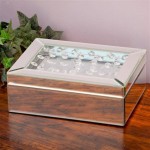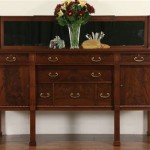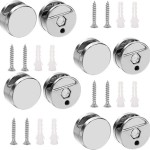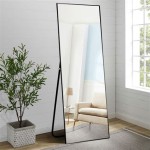Mirror Tiles on Wall: A Comprehensive Guide
Mirror tiles offer a versatile and impactful way to enhance interior spaces. From creating the illusion of more space to adding a touch of glamour, these reflective surfaces can dramatically transform a room's aesthetic and functionality. This article explores the various aspects of using mirror tiles on walls, covering material choices, installation techniques, design considerations, and maintenance tips.
Types of Mirror Tiles
Several types of mirror tiles are available, each with its unique characteristics and suitability for different applications. Traditional glass mirror tiles offer a classic, high-reflectivity finish, while acrylic mirror tiles provide a lighter, shatter-resistant alternative. Self-adhesive mirror tiles simplify installation, and specialty finishes, like antique or smoked mirror tiles, can add a unique decorative touch. Understanding the differences between these options is crucial for selecting the right tile for a specific project.
Choosing the Right Mirror Tile
Selecting the appropriate mirror tile involves considering factors like location, desired aesthetic, and budget. For high-moisture areas like bathrooms, glass mirror tiles are typically preferred due to their moisture resistance. Acrylic tiles are a safer option for children's rooms or high-traffic areas. Budget also plays a significant role, with acrylic tiles generally being more affordable than glass counterparts. The size and shape of the tiles also contribute to the overall visual effect, with smaller tiles offering more intricate design possibilities and larger tiles creating a more seamless, expansive look.
Preparing the Wall Surface
Proper wall preparation is essential for successful mirror tile installation. The surface should be clean, dry, and smooth. Any imperfections, like cracks or bumps, should be addressed before tiling to ensure proper adhesion and a flawless finish. For glossy surfaces, light sanding can improve adhesion. A primer may also be necessary to create a suitable bonding surface, especially for porous materials like drywall. Careful preparation ensures the longevity and visual appeal of the finished project.
Installation Methods for Mirror Tiles
Mirror tiles can be installed using various methods, including adhesives, clips, and grout. Self-adhesive tiles offer the easiest installation, simply peeling and sticking them to the prepared surface. For more demanding applications, construction adhesive provides a stronger bond. Clips and grout offer a more traditional tiling approach, creating a subtle grid pattern between the tiles. The chosen method depends on the type of tile, the wall surface, and the desired aesthetic.
Design Considerations and Applications
Mirror tiles offer a multitude of design possibilities. Strategically placed tiles can brighten dark corners, create the illusion of a larger space, and add a touch of elegance. They can be used as a backsplash in kitchens and bathrooms, as a decorative accent wall in living rooms, or even to create unique furniture pieces. Understanding the impact of light reflection and the interplay of shapes and sizes allows for creative and impactful design choices. Incorporating mirror tiles with other materials like wood, metal, or stone can add depth and visual interest.
Maintaining and Cleaning Mirror Tiles
Maintaining the pristine appearance of mirror tiles requires regular cleaning. Gentle cleaning solutions and soft cloths are recommended to avoid scratching the reflective surface. Avoid abrasive cleaners and harsh chemicals, which can damage the tile's finish. Regular dusting can prevent the buildup of dirt and grime. Promptly addressing any spills or stains can prevent permanent markings. Proper maintenance ensures the longevity and beauty of the mirror tile installation.
Safety Precautions during Installation and Handling
Working with mirror tiles requires attention to safety. Gloves should be worn to protect hands from sharp edges. Eye protection is crucial, especially when cutting or drilling tiles. Proper ventilation is necessary when using adhesives or cleaning solutions. Disposing of broken tiles carefully prevents injuries. Adhering to safety guidelines ensures a safe and successful installation process.
Enhancing Spaces with Creative Mirror Tile Layouts
Beyond standard grid patterns, mirror tiles can be arranged in various creative layouts to create unique visual effects. Diagonal patterns, herringbone designs, or even incorporating different sized tiles can add a dynamic element to the space. Combining mirror tiles with other decorative materials like mosaic tiles or textured wallpaper can further enhance the visual appeal and create a personalized aesthetic.

Antique Mirror Tiles Glass Backsplash

Mirror Walls And Tiles Mirrorworld

Mirror Bevelled Wall Tiles Bathroom Kitchen Splashback Bevel Edge Glass

Antique Mirror Tile A K1 12x12 Blow Out

Abolos Blue Diamond Beveled Square 8 In X Glass Mirror Wall Backsplash Tile 16 Sq Ft Case Ghmref0808 Gr The Home Depot

Large Mirror Wall Decorative Glass Tiles Elevator Background Decoration Mosaic China Bathroom Made In Com

Mirrored Walls And Wall Tiles Pinesway Glass Ltd

Decorative Mirror Tiles On The Wall Decor Living Room Bedroom

Antique Mirror Tiles Backsplash Müller Designs

Abolos Reflections Diamond Grade Gold Mirror 8 In X Mirrored Glass Subway Wall Tile 16 Sq Ft Carton The Department At Com








